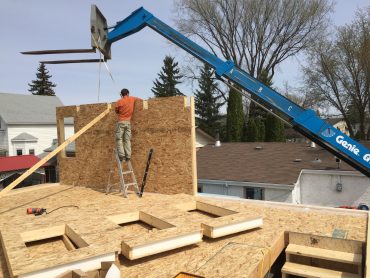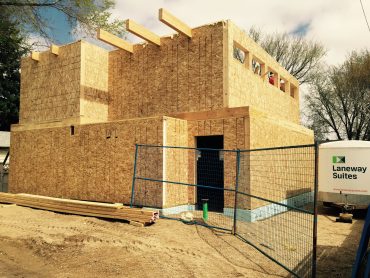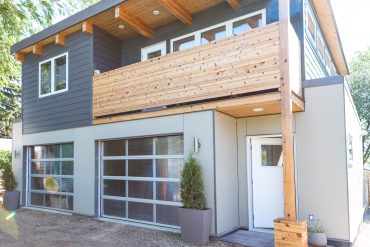
John Bleasby
Building with SIPs: Fast, economical and energy efficient
Canadian ContractorStructured Insulated Panels point to a new future for residential construction
Framing, closing in, window and door blocking, headers, insulating, vapour-barriers: wouldn’t be great if all this could be achieved in one easy step? Pre-fabricated Structured Insulated Panels, or SIPs, make this goal increasingly achievable and economical in the residential construction industry.
What are SIPs?
Structural insulated panels (SIPs) consist of an insulating EPS foam core sandwiched between two structural facings, usually oriented strand board (OSB). SIPs are custom-manufactured under factory controlled conditions and can be fabricated to fit nearly any building design. The result is a building system that is extremely strong, energy efficient and cost effective.

Prefabricated right down to window and door openings, SIPs assemble quickly with the help of a boom truck
Faster assembly, smaller crew
From an assembly standpoint, SIP’s require a much smaller crew than a stick-framed building. The fact that SIPs are delivered made-to-measure with all window and door blocking completed means they fit together quickly and precisely, needing only a boom truck. Manufacturers claim that an average 2,000 square foot house can be assembled in one day.
Any cost comparisons to traditional framing techniques requires consideration of the time saved, and the fact that insulation and vapour barriers are integrated in SIPs. Building waste is also reduced substantially. From an energy efficiency standpoint, the R-values are high and thermal bridging almost entirely eliminated. In fact, the Oak Ridge National Laboratory (ORNL) in Oak Ridge, TN, conducted whole-wall R-value studies that showed a 4-inch SIP wall (nominal) rated at R-14 outperformed a 2×6 stick framed wall with R-19 fiberglass insulation, and was 15 times more airtight than its stick framed counterpart with fiberglass insulation. The energy efficiency extends to the EPS foam itself, given that it takes 24 per cent less energy to produce EPS than fiberglass insulation of equivalent R-value.
Energy efficiency and high air quality
Air quality is always an issue with today super-tight house, and SIPs are among the tightest available. Since the components used to make SIPs (foam, oriented strand board, and adhesive) do not contain any VOCs or other harmful chemicals that can affect occupant health, they meet some of the most stringent standards for indoor air quality.
SIP panels offered by leading manufacturers like EnerSip in Dominion City, MB, come in sizes from 4’x8’ to 8’ x 24’ to suit almost any design configuration. R-values ranging from R-42 to R-48 in roofs, R-15 to R-33 in walls, and R-33 toR-42 in floor panels will meet the most stringent code requirements. The continuous span of OSB panels eliminates the need to search for studs when finishing the interior.

On Jeff Nattress’s laneway home, the large glulam beams span 32 feet. SIP roof panels then sit on top, only 10 inches thick
Problem solvers for unique situations
SIPs can also solve some specific building challenges like no other. When Saskatoon builder and developer Jeff Nattress was creating his garage suite pilot project for his new company Laneway Suites, he learned that maximizing the 760 square feet of second floor living space in keeping with the city’s 20 feet height limit could be very restrictive. A sloped roof would not work.
However, while a flat roof was the solution in terms of design, it had to be “really thin” with a high R-value. Together with his designer, Crystal Bueckert of Bldg Studio Inc., Nattress discovered that SIPs were the answer. “It was a no-brainer to do a SIP roof,” says Beuckert. The 10 inch thick SIP roof is supported by Douglas fir glulam beams, 5 1/2 inches wide

Although many of the window and door cutouts were pre-manufactured, Nattress choose to do others on site.
and 12 inches deep running the 32 foot length of the home, and was treated as a wall system under the building code. This eliminated the requirement for airspace between roof deck and the finished ceiling on the interior, and allowed an open floor plan with high ceilings wall-to-wall.
“The idea here was to make the build as simple as possible,” says Nattress. Crystal Beuckert agrees. “SIPs were a great application for a project like this,” she says. “There was less stress on the laneway and less disruption for the neighbors because the build was so fast.”
Read more….
Watch a video about SIPs
Sustainable building with SIPs
Follow John on Instagram and on Twitter for notifications about our newest posts 
Advertisement
Print this page


Good afternoon, I enjoyed the article very much. The only thing missing is the cost per sqarre foot. Would it be possible to provide that info? My plans are for a 1000 sq ft house. Thank you.